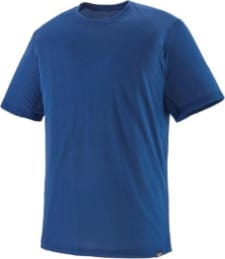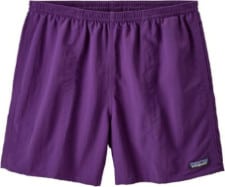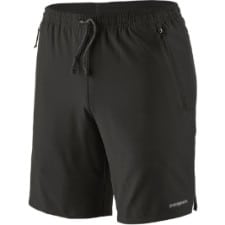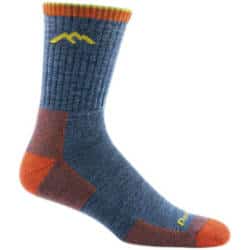Your backpacking clothes for an Appalachian Trail don’t have to be overly complicated—in fact, simpler is better because you don’t want to carry anything you won’t use. What you do want is durable clothing, doesn’t chafe or rub you the wrong way, and is easy to care for because you’re going to be hiking all day, every day in it.
Overall, here’s the clothing I think is essential for a three-season Appalachian Trail thru-hike or section hike. This is what I’d bring.
-
- a hiking top and bottom
- hiking socks
- underwear
- a rain jacket
- an insulated jacket
- fleece or merino wool mid-layer sweater
- gloves or mittens
- fleece or wool beanie
- multi-use neck gaiter
- camp baselayers (top and bottom)
Hiking Tops
When you’re thru-hiking or section hiking the Appalachian Trail, you’re going to be generating a lot of body heat, so you want a shirt that’s going to be comfortable under a backpack and that will dry quickly when you perspire. Some people like merino wool shirts because stink less than synthetic shirts, but trust me, anything you wear is going to reek after a few days of hiking, let alone a few weeks.
Patagonia Capilene Cool Trail Tee
For Men and Women: The Capilene Cool fabric is incredibly lightweight and silky. It wicks sweat and dries rapidly, and the cut is long enough to not bunch under a pack. These shirts are virtually indestructible, which is a good thing on a long trail. I also like Patagonia’s Capilene Cool Tank Tops.
REI Active Pursuits Shirt
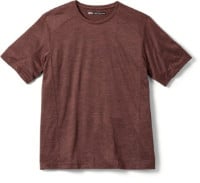 For Men and Women: This is a basic technical tee-shirt with a mid-range fit and various colors. This shirt has flat seams for non-chafing comfort and a reflective hit on the back to keep you visible at night. It’s made entirely of polyester, so it’s easy to rinse out though and dries quickly. It’s also comparatively inexpensive and frequently on sale.
For Men and Women: This is a basic technical tee-shirt with a mid-range fit and various colors. This shirt has flat seams for non-chafing comfort and a reflective hit on the back to keep you visible at night. It’s made entirely of polyester, so it’s easy to rinse out though and dries quickly. It’s also comparatively inexpensive and frequently on sale.
Hiking Pants
Do you prefer to hike in shorts or pants? For shorts, most hikers like a longer inseam—around five inches for women and eight inches for men. For pants, make sure they sit high enough that your pack’s hip belt won’t push them down, and always look for a flatlock inseam. Remember for this layer, you’re perfectly fine finding a pair of technical shorts and teeshirt at your local sporting goods store. Your hiking layers are one place you can skimp and not worry too much.
Patagonia Baggies
For Men and Women: A hiker fave, these Patagonia shorts will last for thousands of miles. There are several inseam options for both men and women, and they come in a variety of quirky patterns that will clash beautifully with your weird hiker outfit.
Patagonia Multi Trails Shorts
For Men and Women: This line of shorts has a perfect-length inseam, an airy feel, and are slit up the sides for maximum range of motion. The shorts are built with a DWR coating on the face fabric and have a boxer-brief liner to help prevent chafing. Yes, no underwear is required.
Janji Trail Tight
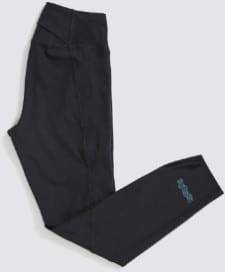 For Men and Women: Janji’s trail tights have lots of pockets, fit great, and are great for hiking in cooler weather, from freezing up to about 50 degrees. Janji finally figured out men’s trail running and hiking tights. The women’s model has a high-rise fit, and they’re one of the few tights available that doesn’t constantly slide down when hiking. I love the colors, too!
For Men and Women: Janji’s trail tights have lots of pockets, fit great, and are great for hiking in cooler weather, from freezing up to about 50 degrees. Janji finally figured out men’s trail running and hiking tights. The women’s model has a high-rise fit, and they’re one of the few tights available that doesn’t constantly slide down when hiking. I love the colors, too!
Hiking Socks
Don’t skimp on the socks. Choose a technical, hiking-specific sock that advertises arch support, reinforced toe and heel, and light padding. Sock height is up to you, but many hikers opt for a mid-height crew sock to help prevent debris from getting in your shoes.
Darn Tough Hiker Micro Crew
For Men and Women. These are some of the most popular socks on the AT. All Darn Tough socks are made in the US, have a lifetime guarantee, and have perfected the fit and level of cushion. These are made from a tightly woven merino/spandex blend. If you ever wear them out Darn Tough will replace them for free.
Swiftwick Pursuit Seven
 For Men and Women. Swiftwick combines merino with Olefin fibers for a sock that doesn’t shift in your shoe, won’t slide down your ankle, and wicks moisture. These socks dry super fast and have a seamless construction so they don’t rub. They’re also available in all kinds of colors and rad patterns, making them easy to sort at a laundromat.
For Men and Women. Swiftwick combines merino with Olefin fibers for a sock that doesn’t shift in your shoe, won’t slide down your ankle, and wicks moisture. These socks dry super fast and have a seamless construction so they don’t rub. They’re also available in all kinds of colors and rad patterns, making them easy to sort at a laundromat.
Injinji Nuwool Liner Socks
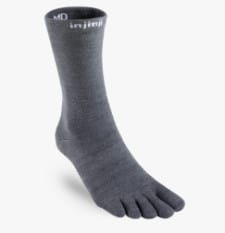 For Men and Women. Yes, these are toe socks. You either love them or you hate them. Some hikers swear by using the liners under another pair of socks to prevent blisters/rubbing, and some hikers just like having their toes separated.
For Men and Women. Yes, these are toe socks. You either love them or you hate them. Some hikers swear by using the liners under another pair of socks to prevent blisters/rubbing, and some hikers just like having their toes separated.
Underwear
Ex Officio Give-N-Go Underwear
 For Men and Women. Some hikers wear underwear, others don’t. No judgment either way. Ex Officio’s underwear is antimicrobial and made specifically for wearing, rinsing, and re-wearing and they have a variety of styles to choose from that suit a wide range of preferences, from boxers to full cut panties, bikinis, and thongs!
For Men and Women. Some hikers wear underwear, others don’t. No judgment either way. Ex Officio’s underwear is antimicrobial and made specifically for wearing, rinsing, and re-wearing and they have a variety of styles to choose from that suit a wide range of preferences, from boxers to full cut panties, bikinis, and thongs!
Rain Jacket
Your rain jacket should weigh less than 10 ounces and be long enough to cover your butt. A 2.5 or three-layer construction with an ePTFE membrane is your best bet here, instead of a PU laminate. In normal talk, this means the jacket is waterproof and breathable. Look for tags with Gore-Tex, eVent, or Pertex. Keep in mind that I’ve never found a rain jacket that keeps you totally dry in long, heavy rain. Water will eventually drip down your neck, or you’ll get sweaty and clammy wearing it for 12 hours at a time.
Some hikers like rain pants—I’m not one of them, and I saw a lot being sent home on the AT. When they get wet and sticky, they tend to stick to your legs.
Outdoor Research Helium Rain Jacket
For Men and Women. OR seems to redesign the Helium Jacket every few years to be even lighter and more streamlined. The men’s model weighs just a hair over six ounces, and it’s built with 2.5-layer Pertex Shield. It’s simple and packs down to almost nothing, but it has an adjustable hood and chest pocket that’s perfectly sized to carry a smartphone.
Lightheart Gear Rain Jacket
For Men and Women. The Lightheart Gear Rain Jacket is a fully-featured and seam-taped rain jacket with an adjustable hood, pit zips, velcro wrist cuffs, interior and exterior pockets, and a drawcord hem. It’s made with siliconized polyester (silpoly), which is a permanently waterproof fabric, so you’ll never need to restore a DWR layer because it doesn’t have one. Lightheart Gear is a cottage manufacturer that sews all of its jackets. It’s also available in a nice variety of colors. The sizing is unisex.
Insulated Jacket
Look for a jacket that weighs less than 12 ounces. To be warm enough, this usually means at least 800 fill-power down insulation. If you’re waffling between down or synthetic, synthetic fill has come a long way in warmth-to-weight ratio, but many people still swear by down. There are pros and cons to both—synthetic doesn’t pack down as small but keeps its warmth when wet. Down can be loftier, but if it gets wet, you’re hosed.
Feathered Friend Eos
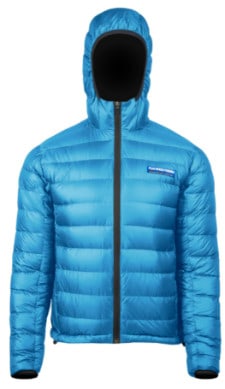 For Men and Women: The Eos Down Jacket is the lightest offering from this top-of-the-line down sleeping bag and apparel company. Packed with 900-fill down, the women’s model weighs nine ounces, and the men’s model weighs 10.6 ounces. It has a deep hood and a more fitted feel than some boxier offerings. It’s also never on sale or discounted because it’s the best of the best and in very high demand.
For Men and Women: The Eos Down Jacket is the lightest offering from this top-of-the-line down sleeping bag and apparel company. Packed with 900-fill down, the women’s model weighs nine ounces, and the men’s model weighs 10.6 ounces. It has a deep hood and a more fitted feel than some boxier offerings. It’s also never on sale or discounted because it’s the best of the best and in very high demand.
Enlightened Equipment Torrid APEX
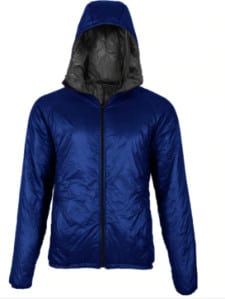 For Men and Women: The Torrid APEX is the synthetic-fill jacket of your dreams. It has a similar warmth-to-weight ratio as high-loft down, but you won’t lose insulating capabilities if it gets damp. The Climashield Apex synthetic insulation is laid out in sheets, so there are no cold spots, and it weighs less than eight ounces.
For Men and Women: The Torrid APEX is the synthetic-fill jacket of your dreams. It has a similar warmth-to-weight ratio as high-loft down, but you won’t lose insulating capabilities if it gets damp. The Climashield Apex synthetic insulation is laid out in sheets, so there are no cold spots, and it weighs less than eight ounces.
Montbell Plasma 1000
 For Men and Women. I’m still on the fence about whether 1,000-fill down is a real thing, but this incredibly lightweight jacket comes in under five ounces and has a unique baffle stitching pattern to help eliminate cold spots and keep the down in place. The downside of this jacket is that it doesn’t have a hood. But a fleece or wool beanie is usually sufficient to wear on the AT if your head gets cold.
For Men and Women. I’m still on the fence about whether 1,000-fill down is a real thing, but this incredibly lightweight jacket comes in under five ounces and has a unique baffle stitching pattern to help eliminate cold spots and keep the down in place. The downside of this jacket is that it doesn’t have a hood. But a fleece or wool beanie is usually sufficient to wear on the AT if your head gets cold.
Midlayer Insulation
Most hikers start their northbound treks in early spring, which can be quite cold through the Smokies. Southbound hikers will likely be hiking into late fall, which will also be chilly. Choose a hiking mid-layer with a natural or synthetic technical fiber that wicks sweat, stays as stink-free as possible, and is on the lighter / more packable side. Often your old ski base layer or that lightweight fleece collecting dust in your closet will work fine.
Smartwool Cassic Thermal Quarter-Zip Pullover
For Men and Women: This is the most packable option, and one of my favorites for fit and activity. I’ve had mine for eight years, and there are a few runs in the fabric, but after thousands of miles of wear and being crammed in a pack, it’s in remarkable shape. Being wool, it resists the stink. It’s also surprisingly affordable.
Farpointe Alpha Cruiser Hoodie
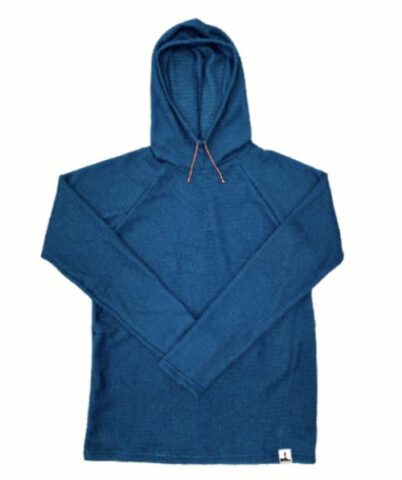
For Men and Women. The Farpointe Polartec Alpha Direct Hoodie is extremely lightweight and warm, especially when layered under a windbreaker or rain jacket. It dries very fast when wet and has a very soft hand that is delightful to wear when hiking or sleeping.
Appalachian Gear Company All-Paca Fleece Hoodie
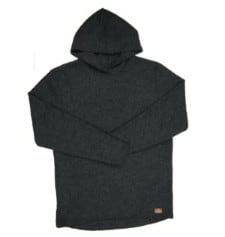 For Men and Women. These hoodies have exploded in popularity with hikers over the past three years, and each new shipment sells out quickly. It has an incredible warmth-to-weight ratio, is a hydrophobic alpaca fleece fiber that doesn’t collect water and is the most odor-resistant material I’ve ever worn. These tend to run big, so order a size down if you’re unsure.
For Men and Women. These hoodies have exploded in popularity with hikers over the past three years, and each new shipment sells out quickly. It has an incredible warmth-to-weight ratio, is a hydrophobic alpaca fleece fiber that doesn’t collect water and is the most odor-resistant material I’ve ever worn. These tend to run big, so order a size down if you’re unsure.
Gloves and Headwear
Outdoor Research Woolly Sensor Liner Gloves
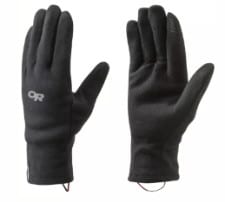 For Men and Women. A basic set of lightly insulated liner gloves are all most people will need, although touchscreen compatibility is handy for using the Guthook Hiker app. Early AT starters might want to pack a pair of mittens through the Smokies (holding onto trekking poles can get cold), but for the most part, simple liner gloves will do the trick.
For Men and Women. A basic set of lightly insulated liner gloves are all most people will need, although touchscreen compatibility is handy for using the Guthook Hiker app. Early AT starters might want to pack a pair of mittens through the Smokies (holding onto trekking poles can get cold), but for the most part, simple liner gloves will do the trick.
Smartwool Merino Beanie
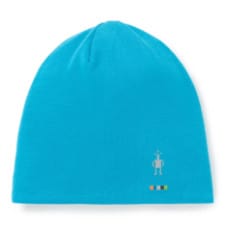 For Men and Women. Similar to the gloves, any lightweight, snug beanie made from merino or other natural fibers will be perfect for cold nights at camp, or chilly hiking mornings. Stashing a beanie in your side pocket can help avoid donning and shedding layers—protecting your head will keep you comparably warm to an additional mid-layer.
For Men and Women. Similar to the gloves, any lightweight, snug beanie made from merino or other natural fibers will be perfect for cold nights at camp, or chilly hiking mornings. Stashing a beanie in your side pocket can help avoid donning and shedding layers—protecting your head will keep you comparably warm to an additional mid-layer.
Original Buff
 For Men and Women. This is the do-it-all accessory that isn’t entirely necessary, but you’ll never be sorry you have it. I used mine as a headband in warmer weather, then pulled it down over my ears on colder days when I didn’t want to wear a hat. It’s great for wiping internal condensation off the walls of your tent or as a washcloth at the end of the day.
For Men and Women. This is the do-it-all accessory that isn’t entirely necessary, but you’ll never be sorry you have it. I used mine as a headband in warmer weather, then pulled it down over my ears on colder days when I didn’t want to wear a hat. It’s great for wiping internal condensation off the walls of your tent or as a washcloth at the end of the day.
Camp Base Layers
These are base layers to wear at camp after a long day of hiking. Your body cools off after hiking all day, and it’s nice to change into a warm, dry set of clothes in camp for relaxing and sleeping in. The primary considerations with camp clothes are low weight, packability, and stink resistance. A lightweight set of baselayers works great. They don’t have to be too warm or bulky since you’ll be in your sleeping bag, or you can always throw a jacket over them at camp. They can also be used during cold snaps when you want a little more insulation, or you can wear them in town when you’re washing the rest of your clothes at a laundromat.
REI Co-op Midweight Baselayer Tops and Bottoms
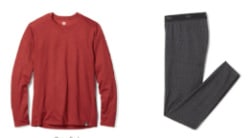 For Men and Women. These basic base layers can often be found on sale. They’re available in merino wool or synthetic fabric for hikers who find wool itchy. You can buy a name brand and pay more, but the quality of these REI baselayers is really good.
For Men and Women. These basic base layers can often be found on sale. They’re available in merino wool or synthetic fabric for hikers who find wool itchy. You can buy a name brand and pay more, but the quality of these REI baselayers is really good.
Patagonia Capilene Midweight Tops and Bottoms
 For Men and Women. Patagonia’s classic Capilene synthetic base layer material is breathable and warm, with a classic mid-range fit. They’re also virtually indestructible: I know people who’ve been using the same Capilene baselayers for over a decade. As a bonus, you won’t look like you’re walking around in your pajamas if you wear these as your town clothes during a zero-day.
For Men and Women. Patagonia’s classic Capilene synthetic base layer material is breathable and warm, with a classic mid-range fit. They’re also virtually indestructible: I know people who’ve been using the same Capilene baselayers for over a decade. As a bonus, you won’t look like you’re walking around in your pajamas if you wear these as your town clothes during a zero-day.
Key Takeaways
When hiking the Appalachian Trail, keep the following advice in mind.
- Plan to rinse out clothing on the trail every day, so with the exception of underwear and socks don’t bring extras. Even there, you want to keep your rotation minimal.
- Buy quality where it matters, save money where it doesn’t. Your hiking layers don’t have to be expensive or fancy.
- You can always correct your mistakes. There are towns and post offices up and down the AT where you can replace items or have new ones sent.
About the author
Kate “Sprouts” Washington has thru-hiked long distance trails in New Zealand, Canada, the Eastern United States and the Pacific Northwest. A midwife, she lives in the Seattle Area and enjoys backpacking with her “tramily” and dogs on weekends.
SectionHiker is reader-supported. We only make money if you purchase a product through our affiliate links. Help us continue to test and write unsponsored and independent gear reviews, beginner FAQs, and free hiking guides.

